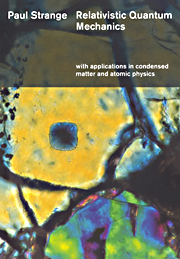Book contents
- Frontmatter
- Contents
- Preface
- 1 The Theory of Special Relativity
- 2 Aspects of Angular Momentum
- 3 Particles of Spin Zero
- 4 The Dirac Equation
- 5 Free Particles/Antiparticles
- 6 Symmetries and Operators
- 7 Separating Particles from Antiparticles
- 8 One-Electron Atoms
- 9 Potential Problems
- 10 More Than One Electron
- 11 Scattering Theory
- 12 Electrons and Photons
- 13 Superconductivity
- Appendix A The Uncertainty Principle
- Appendix B The Confluent Hypergeometric Function
- Appendix C Spherical Harmonics
- Appendix D Unit Systems
- Appendix E Fundamental Constants
- References
- Index
1 - The Theory of Special Relativity
Published online by Cambridge University Press: 11 January 2010
- Frontmatter
- Contents
- Preface
- 1 The Theory of Special Relativity
- 2 Aspects of Angular Momentum
- 3 Particles of Spin Zero
- 4 The Dirac Equation
- 5 Free Particles/Antiparticles
- 6 Symmetries and Operators
- 7 Separating Particles from Antiparticles
- 8 One-Electron Atoms
- 9 Potential Problems
- 10 More Than One Electron
- 11 Scattering Theory
- 12 Electrons and Photons
- 13 Superconductivity
- Appendix A The Uncertainty Principle
- Appendix B The Confluent Hypergeometric Function
- Appendix C Spherical Harmonics
- Appendix D Unit Systems
- Appendix E Fundamental Constants
- References
- Index
Summary
Relativistic quantum mechanics is the unification into a consistent theory of Einstein's theory of relativity and the quantum mechanics of physicists such as Bohr, Schrödinger, and Heisenberg. Evidently, to appreciate relativistic quantum theory it is necessary to have a good understanding of these component theories. Apart from this chapter we assume the reader has this understanding. However, here we are going to recall some of the important points of the classical theory of special relativity. There is good reason for doing this. As you will discover all too soon, relativistic quantum mechanics is a very mathematical subject and my experience has been that the complexity of the mathematics often obscures the physics being described. To facilitate the interpretation of the mathematics here, appropriate limits are taken wherever possible, to obtain expressions with which the reader should be familiar. Clearly, when this is done it is useful to have the limiting expressions handy. Presenting them in this chapter means they can be referred to easily.
Taking the above argument to its logical conclusion means we should include a chapter on non-relativistic quantum mechanics as well. However, that is too vast a subject to include in a single chapter. Furthermore, there already exists a plethora of good books on the subject.
- Type
- Chapter
- Information
- Relativistic Quantum MechanicsWith Applications in Condensed Matter and Atomic Physics, pp. 1 - 22Publisher: Cambridge University PressPrint publication year: 1998



